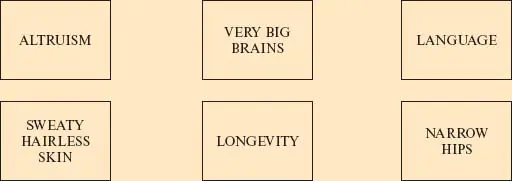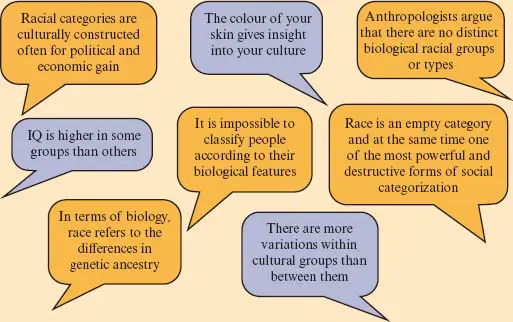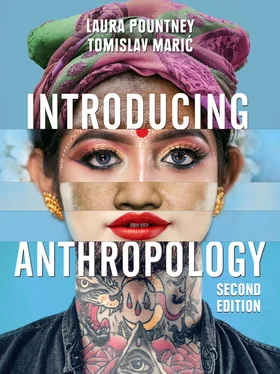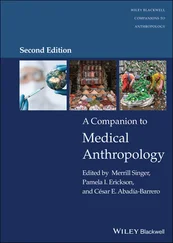There is evidence which indicates that, around 2.6 to 2.8 million years ago, some groups of early humans began collecting tools and food from a variety of places and bringing them to favoured resting and eating spots. Sharing vital resources with other members of the group led to stronger social bonds and enhanced the group’s chances of survival. About 2 million years ago, early humans transported materials such as stone over several miles, from which they made tools for killing animals. Evidence has shown that, around 40,000 years ago, materials such as shells were being transported a long way from their original location, which suggests that humans were sharing resources and communicating with others from a range of different places. This sharing of goods led to the development of exchange systems, which are fundamental to the success of the human species and are a universal feature of all human societies.
By 100,000 years ago, early modern humans buried the dead together with beads and other symbolic objects. Burial rituals heightened the group’s memory of the deceased person. These rituals may imply that such groups shared the belief that a person’s identity extends beyond death. By 24,000 years ago, there is evidence of child burials, with children being buried covered in ochre markings and with mammoth tusks.
Our ancestors used jewellery and other personal adornments to reflect their identity. These adornments may have represented membership in a particular group or someone’s age, sex and social status.
List as many advantages as you can of the specific ways in which humans evolved culturally.
Evolution in humans has selected for:
very big brains – we can deal with complex and abstract concepts;
language – we are able to store and transmit knowledge;
narrow hips – we can run, but giving birth is difficult and our babies are immature;
sweaty/hairless skin – to help regulate temperature, e.g., to keep cool when running;
longevity – humans are among the only primates that live beyond the menopause;
altruism – we have empathy for other humans.
How might the characteristics below be linked? Draw arrows between the boxes and explain the connections.

How Do Humans Vary? The Concept of Race and a Critique of the Concept
Biological differences between humans
It is now agreed that Homo sapiens evolved from one of many types of early human and then spread around the world, interacting with other forms such as Neanderthals and gradually displacing these other types, though continuing to carry the genetic material from other early humans.
From research into the DNA of modern humans, there is increasing evidence that early humans mixed and had sex, and that this tended to be more likely between neighbouring groups. Using genetic information, it is now possible to investigate people’s ancestry as well as trace their movements. For example, it has been found that 95 per cent of Icelandic men have Norse ancestry, whereas 85 per cent of Icelandic women have Celtic ancestry, which indicates that they had relations with Celtic men on their way to Iceland. This kind of information tells us a lot about the kinds of social relationships occurring between groups.
It is clear that there are some physical differences between human groups. These are based on minor genetic differences and the variations that have arisen further from these lineages. For example, we know that Inuit are different from Australians, and no one confuses the !Kung San hunter-gatherers from the Kalahari desert with the Bantu farmers. Therefore ancestry, in biological terms, refers simply to specific genetic lineage.
In wider society, the concept of race has been interpreted in a number of ways. During the nineteenth century there were several attempts to create stratified categories of race along the lines of perceived (or given) physical and intellectual differences between various social groups. Often, these categories were created to reflect power differences.
Are the statements below correct or incorrect? Give reasons for your responses.

Some early attempts to understand the differences between humans resulted in taxonomies or classification systems that were often crude and based judgementally on superficial physical differences. For example, in 1757 Carl Linnaeus divided Homo sapiens into five categories, among which were ‘wild man’, who was apparently mute and hairy, and ‘European’, who was ‘gentle’. Significantly, Linnaeus conflates physical characteristics such as hair type with cultural differences such as dress and political organization. This is a highly problematic assumption and one that is reflected in many ways by the widespread racismthat has occurred in almost every single society in the world.
racismDiscrimination against an individual or group based on their perceived ethnicity and the idea that ‘race’ is a fixed and bounded reality
Culturally constructed concepts of race
It is now widely accepted that there are minor biological variations between humans. However, it is the social and political interpretations of the real or imagined differences between people on which cultural anthropologists now focus: the culturally constructedconcepts of race.
culturallyconstructed Something which is created by society
Varying skin colour provides a useful example for considering the differences between biological and sociopolitical approaches to the concept of race. Skin colour in humans correlates quite closely with the ancestral location of the people concerned because it has largely been determined by the ultraviolet radiation level in that particular ancestral homeland. As such, it is a reasonable indication of genetic origins, although it does not take into account population movement. Cultural anthropologists are interested in the ways that skin colour has been assigned particular political and social status, both historically and in contemporary society, as the basis of forms of discrimination. They study the reasons why and how the socially constructed concept of race becomes assigned with greater significance at certain times and in certain places.
A useful example is in the naming of groups. It is very unusual for people to use outsiders’ terms of discrimination to describe themselves. One of the few examples in which they do is the term ‘Welsh’, which is a corruption of the Anglo-Saxon word for ‘slave’ ( wealish ), as opposed to the word Cymraeg , which is the correct Welsh word. The word ‘Welsh’ has stuck and has even eventually been adopted by the Welsh themselves.
American Association of Physical Anthropologists’ (AAPA) Statement on Race and Racism (2019)
In an attempt to ensure that anthropology was not associated with any discriminatory or colonial attitudes concerning race, and to provide a unified approach to the issue, a statement was issued in 1988 by the American Anthropological Association (AAA) condemning the misuse of culturally constructed notions of racial differences. What recent work in evolutionary anthropology has shown is that, although some genetic differences in skin colour, a predisposition to certain diseases and varying levels of ability to digest lactose (the protein in milk) or alcohol do exist among human populations, there is no evidence that cognitive or behavioural traits (such as IQ) show any variation. For this reason, human evolutionary studies have actively contributed to the demise of pseudo-scientific racial classifications of intelligence.
Читать дальше














